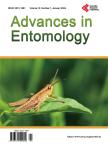Impact of Urban Agriculture on the Species Distribution and Insecticide Resistance Profile of <i>Anopheles gambiae s.s.</i>and <i>Anopheles coluzzii</i>in Accra Metropolis, Ghana
Impact of Urban Agriculture on the Species Distribution and Insecticide Resistance Profile of <i>Anopheles gambiae s.s.</i>and <i>Anopheles coluzzii</i>in Accra Metropolis, Ghana作者机构:Vestergaard-NMIMR Vector LabsParasitology DepartmentNoguchi Memorial Institute for Medical Research(NMIMR)University of GhanaAccraGhana Parasitology DepartmentNoguchi Memorial Institute for Medical Research(NMIMR)University of GhanaAccraGhana African Regional Postgraduate Programme in Insect Sciences(ARPPIS)University of GhanaAccraGhana Vestergaard East AfricaNairobiKenya VestergaardWashington DCUSA
出 版 物:《Advances in Entomology》 (昆虫学(英文))
年 卷 期:2018年第6卷第3期
页 面:198-211页
学科分类:1002[医学-临床医学] 100214[医学-肿瘤学] 10[医学]
主 题:Anopheles gambiae s.s. Anopheles coluzzii Insecticide Resistance Malaria Piperonyl Butoxide (PBO) Urban Agriculture
摘 要:Malaria incidence in urban areas has generally been low compared to rural areas but recent data indicate that urban malaria remains a public health problem. It is therefore important to understand the factors that promote urban malaria to help formulate future vector control strategies. This study compared Anopheles gambiae s.l. (A. gambiae s.l.) species composition, distribution and insecticide resistance mechanisms between vegetable and non-vegetable growing areas in Accra Metropolis. Four sites were selected within the city of Accra which comprised of two vegetable-growing and two non-vegetable growing areas. WHO susceptibility tests were carried out on adults A. gambiae s.l. reared from larvae collected from the sites. Five insecticides were tested and the A. gambiae complex, resistance genotypes and enzyme activities of each population were characterized. All A. gambiae s.l. populations tested were resistant to all the insecticides, but relatively lower mortalities were observed in the vegetable growing areas. The mortality against 0.05% deltamethrin was 2.6% (Opeibea) and 12.5% (Korle-Bu) for the vegetable growing areas and 36.2% (Achimota) and 38.9% (Mataheko) in the non-vegetable growing areas. Anopheles gambiae s.s. (95% of Opeibea population) and Anopheles coluzzii, (98% of Korle-Bu population) were the dominant species in the vegetable growing areas. The voltage-gated sodium channel (Vgsc-1014F) frequencies of all the populations were similar but the acetylcholinesterase (ace-1) frequencies were significantly lower (p A. gambiae s.l. from Opeibea than from the other areas. The contribution of urban agriculture in the development of insecticide resistance needs to be considered in the formulation of future vector control strategies alongside other domestic usages.



